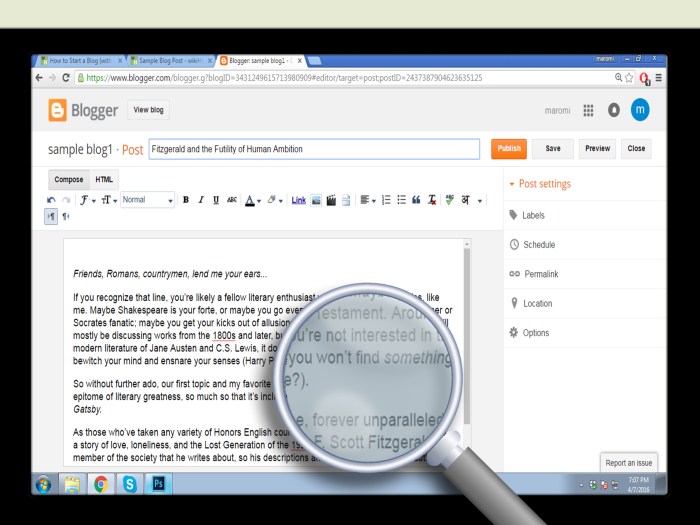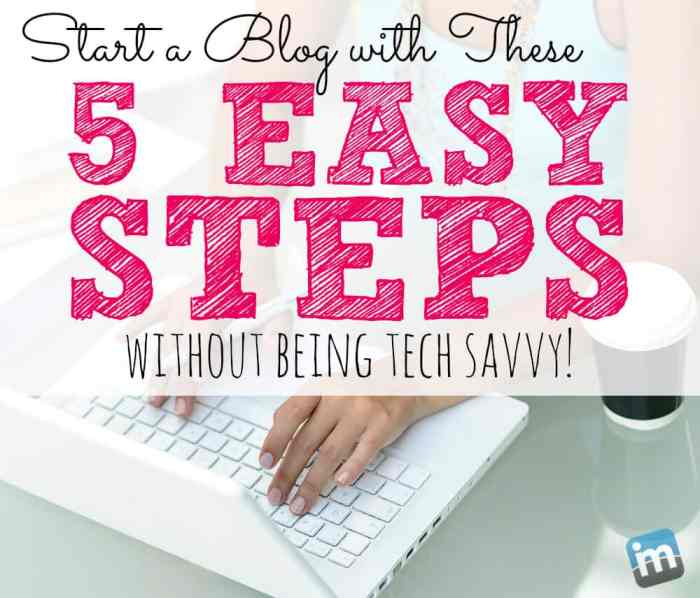How to Start a Blog – diving into the world of blogging where creativity meets technology, this guide is here to help you kickstart your blogging journey with style and flair.
From understanding the basics to building a loyal audience, this guide covers it all in a way that’s easy to digest and implement.
Understanding Blogging
A blog is a type of website where an individual or a group of people regularly share their thoughts, opinions, and experiences on various topics. The main purpose of a blog is to inform, entertain, or engage with readers through written content.
Benefits of Starting a Blog
- Establishing authority in a particular niche or industry.
- Building a community and connecting with like-minded individuals.
- Opportunities for monetization through affiliate marketing, sponsored content, and ads.
- Improving writing skills and creativity.
Types of Blogs
- Personal Blogs: Focus on the author’s personal experiences, thoughts, and reflections.
- Business Blogs: Created by businesses to promote their products, services, or industry-related content.
- Niche Blogs: Concentrate on a specific topic or interest, such as travel, fashion, food, or technology.
Target Audience for a Blog
The target audience for a blog depends on the niche and content being shared. It could range from teenagers interested in gaming to professionals seeking industry insights. Understanding your target audience is crucial for creating relevant and engaging content that resonates with them.
Setting Up Your Blog
Setting up your blog is an exciting step towards sharing your thoughts and ideas with the world. Here are some key aspects to consider when starting your blogging journey.
Choosing a Blogging Platform
When selecting a blogging platform, consider popular options like WordPress, Blogger, or Wix. Each platform offers different features and customization options, so choose one that aligns with your blogging goals and technical skills.
Selecting a Domain Name and Hosting Service
Choose a domain name that reflects your blog’s topic and is easy to remember. Look for a reliable hosting service that ensures your blog is secure, loads quickly, and has minimal downtime.
Importance of Choosing a Responsive Design
Opt for a responsive design for your blog to ensure it looks great and functions well on various devices, including smartphones and tablets. A responsive design improves user experience and can boost your blog’s visibility on search engines.
Customizing Layout and Design
Personalize the layout and design of your blog to make it unique and visually appealing. Experiment with different themes, colors, fonts, and widgets to create a blog that represents your style and brand effectively.
Creating Compelling Content

Creating high-quality content is essential for attracting and retaining readers to your blog. Quality content helps establish credibility, build trust with your audience, and increase engagement on your site. When creating compelling content, focus on providing value, being authentic, and delivering information that is informative, entertaining, or inspiring.
Brainstorming Blog Post Ideas
One way to brainstorm blog post ideas is to consider your passions, interests, and expertise. Think about what topics you are knowledgeable about or what you enjoy writing about. You can also look at popular trends in your niche, conduct research to identify popular topics, or draw inspiration from other blogs or websites. Don’t be afraid to think outside the box and explore unique angles or perspectives for your content.
Different Types of Content
– Listicles: Listicles are popular because they are easy to read and digest. They provide information in a concise and structured format, making it convenient for readers to consume.
– Tutorials: Tutorials are valuable for teaching your audience how to do something step-by-step. They can include screenshots, videos, or detailed instructions to help readers understand the process.
– Reviews: Reviews are useful for providing insights and opinions on products, services, or experiences. They can help readers make informed decisions and trust your recommendations.
Optimizing Content for Search Engines
To optimize your content for search engines, focus on incorporating relevant s naturally throughout your content. Use headings, meta tags, and alt text for images to help search engines understand the context of your content. Create high-quality, engaging content that is easy to read and share, as search engines prioritize user-friendly content. Regularly update and promote your content to improve its visibility and ranking on search engine results pages.
Building an Audience: How To Start A Blog

Building an audience for your blog is crucial for its success. You want to attract readers who will engage with your content, share it with others, and keep coming back for more. Here are some strategies to help you build and grow your audience:
Promoting Your Blog on Social Media
Utilize social media platforms like Instagram, Twitter, Facebook, and Pinterest to promote your blog posts. Share snippets, images, and links to your content to drive traffic to your site.
- Create engaging posts that encourage followers to visit your blog.
- Use hashtags to reach a wider audience and increase visibility.
- Interact with your followers by responding to comments and messages.
Engaging with Your Readers
Engaging with your readers is key to building a loyal audience. Respond to comments on your blog posts, ask for feedback, and create a sense of community around your content.
- Ask questions to encourage discussion and interaction.
- Acknowledge and appreciate your readers’ feedback and contributions.
- Consider hosting Q&A sessions or live chats to connect with your audience in real-time.
Growing Your Email List, How to Start a Blog
Building an email list is a great way to stay connected with your audience and drive traffic to your blog. Offer incentives like free resources, exclusive content, or discounts to encourage visitors to subscribe.
- Place opt-in forms strategically on your blog to capture email addresses.
- Send regular newsletters with valuable content and updates to keep your subscribers engaged.
- Segment your email list based on interests or behavior for targeted communication.
Collaborating with Other Bloggers or Influencers
Collaborating with other bloggers or influencers can help you reach a wider audience and gain credibility in your niche. Consider guest posting on other blogs, hosting joint webinars, or participating in influencer campaigns.
- Reach out to bloggers or influencers in your niche to propose collaboration ideas.
- Cross-promote each other’s content to introduce your audiences to new perspectives.
- Share each other’s content on social media platforms to expand your reach.





